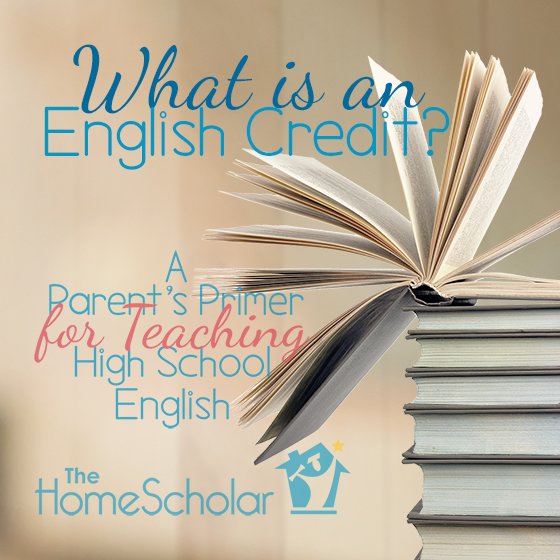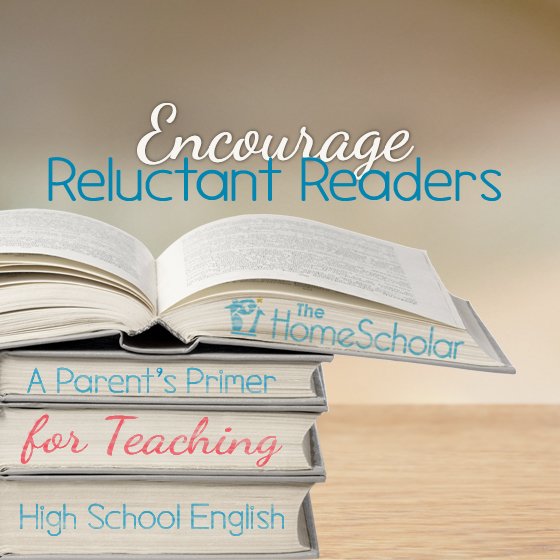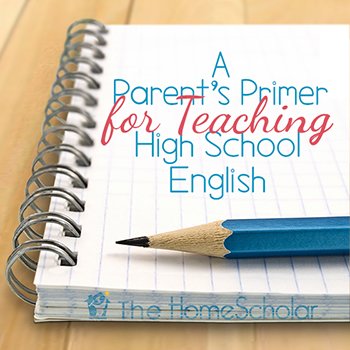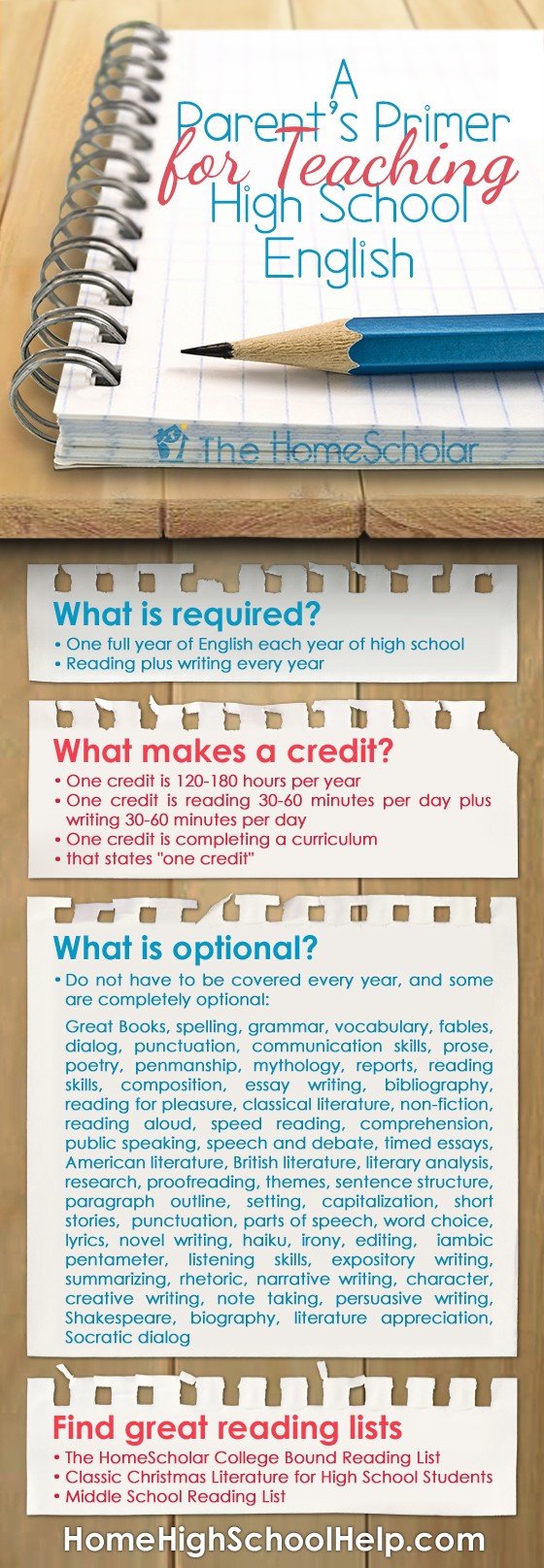
Simplify your approach to English for maximum results
Homeschool parents may need a primer on teaching high school English. American history is filled with great elementary primers that taught kids basic English skills. The New England Primer of the 17th century and the McGuffey Readers of the 19th century were tools parents and teachers relied on to drill the basics into their students. But it isn’t only children who benefit from primers. With so many great choices available, understanding the critical core of high school English will help cut through the confusion.
When you are homeschooling high school, you want to ensure your student is competent in the core English skills. Make sure your child can get into a college if that’s what they decide to pursue. To achieve this goal, it is essential to provide an English credit for every year of high school. Let’s talk about how to simplify your approach to English, so you get maximum results.
Quick Links

What is an English Credit?
Colleges expect to see one English credit for each year of high school. English is a subject that combines communication skills: reading, writing, and speaking. In general, a high school credit includes reading and writing every day. When you buy an English curriculum, it may tell you how many high school credits it is worth. If not, count or estimate hours. An English credit is 120 to 180 hours per year. Estimate the number of hours spent on instruction, practice, and the work of reading and writing.
One English credit includes 30 to 60 minutes of writing activities each day. This may include writing, worksheets, vocabulary workbooks, writing in a journal, spelling, or grammar.
In general, a high school credit includes 30 to 60 minutes of reading every day. It doesn't matter how many books they read. Children might read 6 to 60 books per year. There is a lot of variability. Reading can include books that are fun, classics on a college bound reading list, popular literature, and non-fiction.
Check out these reading lists:
- The HomeScholar College Bound Reading List
- Classic Christmas Literature for High School Students
- The HomeScholar College Bound Reading List
- Middle School Reading List
- The HomeScholar College Bound Reading List
In high school, not all kids continue with skills workbooks. For example, if they already spell reasonably well, spelling may be dropped and English becomes more about writing. Your approach to vocabulary development may also change. You can use games and activities to Play Your Way to a Great Vocabulary. In addition, Rummy Roots and More Rummy Roots can help build vocabulary skills

Choosing Curriculum
Consider a literature based curriculum that blends English and history together. I used Sonlight Curriculum, and here are some others to choose from.
-
Sonlight Curriculum
Tapestry of Grace
My Father's World
The Well-Trained Mind
Robinson Curriculum
Beautiful Feet Books
Veritas Press
Truth Quest History
Notgrass History
AmblesideOnline
If you buy a curriculum that focuses on reading, remember to include writing. If you buy a curriculum that focuses on writing, remember to include some books. Your homeschool English class should include both. But be careful not to overwork your child using multiple programs, unless it’s something your child loves and wants to do.

Literary Analysis Not Required
Literary analysis is not a high school requirement. I thought great homeschools had to include Socratic dialog. After reading books, these mythical homeschoolers enjoy deep and rich conversations about the nuances of great works of literature. They share meaningful discussions about historical perspectives and relevant insights within classical and modern literature.
Meanwhile, I got comments like, “Great book, mom ... what’s next?” I admire parents who include literary analysis, but I simply wasn’t capable. I used a literature based curriculum, so it seems strange to say it, but I hate literary analysis. We preferred to read books all the time.
The truth is, I always felt guilty about not including literary analysis. Every homeschool mom has her “thing” that keeps her awake at night, and literary analysis was a struggle for me. On tests and worksheets my children seemed to have terrible reading comprehension, yet they were reading all the time. They read all day long and late into the night. They laughed and cried and gasped when they read silently to themselves. They begged me to continue when I read aloud to them. How could they do so poorly on reading comprehension questions when they seemed to understand while they were reading?
How do you know when you have succeeded in teaching your child English? When I was homeschooling, I was so stressed out about literary analysis. Every year, I spent a ridiculous amount of time looking at Progeny Press, Learning Language Arts Through Literature, and other curriculum. Why was I failing? Why couldn’t I teach literary analysis? Every time I asked my kids, “How did you like the book?” I never got any insightful dialog about the deeper meaning of the literature.
I finally decided that my goal for literature would be the same as my goal for Bible study. My goal when teaching the Bible was for my kids to love their Bible, not analyze their Bible. Therefore I would teach them to love literature instead of analyze it. I didn’t want to “beat the love of books out of them” by making them analyze everything.
In retrospect, it all ended up great. Ironically, they both ended up in a “Great Books” honors program, analyzing literature at a college level by their own choice! They were able to do college level literary analysis in their honors class without a problem, getting great grades. Their only frustration with the class was reading the occasional book synopsis. “I would rather read the whole thing – they miss the best parts!”
As one mother wrote,
"Honest, good, hard-working homeschooling moms are doing the right thing when they don't tear, claw, dissect, and shred books the children used to love. You know, I thought 'classic' meant 'boring' until I was about 30. Suddenly it struck me that 'classic' means that thousands of avid readers made a list of books they loved and highly recommend."
I may have lost the literary analysis battle, but I won the war. I was stressed out when they were in high school, but I can honestly say that I achieved my goal: they love reading. Keeping the focus on “love of learning” is so difficult, though, when you are faced with a kid who may only answer “fine” when you ask them about their reading. Ultimately, it is the love of reading that matters.

Encourage Reluctant Readers
Your goal is to have your child read 6 to 60 books per year. For reluctant readers, reading the minimum number of books can be a challenge. Allow books below their reading level, so they increase their speed and fluency and gain confidence. Consider reading the first chapter aloud to get them interested in the story and understanding how to pronounce the character names before starting to read the book independently
You want them to read at least 6 books a year with their own eyeballs, but mix in some audio books to increase the number of books they consume, without overwhelming them. Consider using an Amazon Kindle Paperwhite e-reader, which will mask the size of the book from your child and allow you to use a larger font, so it seems like an easier book. For active learners, find books with an active main character, so your child can relate to what they are reading.
Choose short classics when possible. There are many great literary works that are remarkably short, and by simply choosing the short ones, your child is more likely to be successful. Read The Red Badge of Courage (146 pages) instead of War and Peace (1024 pages), The Scarlet Letter (148 pages) instead of Sense and Sensibility (368 pages) , or Old Man and the Sea (128 pages) instead of Moby Dick (486 pages). Other short classics include The Call of the Wild, Frankenstein, Of Mice and Men, and The Pearl.

Record Keeping
When you create your transcript, be specific about class titles. Avoid broad class titles such as “English 9” or “Language Arts.” Instead, remember that reading means “Literature” and writing means “Composition.” So you could call a class “Literature and Composition” if you teach reading and writing. If you emphasized American authors, then consider “American Literature and Composition.”
Keep a high school reading list that includes all books read for school or for pleasure. The reading list can include everything that is considered literature. You can include classic literature, historical reading, popular novels, biographies, and any reading for fun. I usually exclude anything that seems like curriculum. Anthologies are collections of literature excerpts, and can be a little harder to place. When a reading list is already quite long, I suggest leaving the anthology as curriculum, either in the English course description or the history course description (or both!) but not on the reading list
The reading list is not only for high school subjects - it consists of what your child reads each year. It can include literature they read for school subjects, especially when you use a literature based curriculum. Course descriptions do not include reading for fun, but might include books that are assigned for school and that happen to be fun to read.
Create course descriptions that describe your class, the curriculum you used, a description of how you graded, and the books your child read. When you use a literature based curriculum, the boundaries between English course descriptions, history course descriptions, and reading lists get blurry! Instead of thinking you need to divide books between them all, think of it like a Venn diagram.
Books to add only in the English course description include textbooks, workbooks, and curriculum, such as Sonlight Core 100, Spelling Power, Wordly Wise, or Institute for Excellence in Writing High School Essay Intensive. In the history course description, include textbooks, workbooks, and curriculum, such as Sonlight Core 100, Mapping the World By Heart, or A History of US by Joy Hakim.
And there are books that go in both the English course description and the reading list, such as literature read for school. For example, The Red Badge of Courage, or The Call of the Wild. There are books that go in both the history course description and the reading list, such as biographies and historical fiction read for school. For example: Autobiography of Benjamin Franklin or Farewell to Manzanar. If books fit in both the history course description and the English course description, I would put the autobiographies in history and the historical novels in English, even though they help the child learn about both subjects.
Because homeschoolers who use a literature based curriculum have so many books in the reading list (and always will, no doubt), I'd be tempted to remove the more schoolish books (such as Famous Men of Greece) and put them only in the course description, rather than on the reading list. But you know, this is only a preference. Most public high school kids read 5 to 10 books a year, so there is no need to include everything, and these completely overlap! Although my son, Alex, read Jane Austen's books for fun and should have had those books on his reading list, the same books were also on Kevin’s reading list, even though he didn't think it was much fun at all!

Focus on What's Important
Teaching English in high school is easy if you keep your focus on what is important – encouraging your child to love books and write competently. Of these two goals, the first, in my opinion, is the most important. A passion for reading will stay with a child through college and into adulthood. In addition, someone who loves literature – especially excellent literature – will learn to write better naturally, simply by having the voice of the author in their head.






